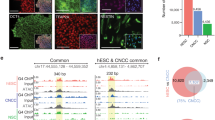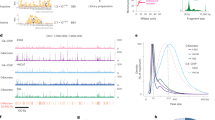Abstract
DNA and histone modifications regulate transcriptional activity and thus represent valuable targets to reprogram the activity of genes. Current epigenetic therapies target the machinery that regulates these modifications, leading to global transcriptional reprogramming with the potential for extensive undesired effects. Epigenetic information can also be modified as a consequence of disrupting processive DNA replication. Here, we demonstrate that impeding replication by small-molecule-mediated stabilization of G-quadruplex nucleic acid secondary structures triggers local epigenetic plasticity. We report the use of the BU-1 locus of chicken DT40 cells to screen for small molecules able to induce G-quadruplex-dependent transcriptional reprogramming. Further characterization of the top hit compound revealed its ability to induce a dose-dependent inactivation of BU-1 expression in two steps: the loss of H3K4me3 and then subsequent DNA cytosine methylation, changes that were heritable across cell divisions even after the compound was removed. Targeting DNA secondary structures thus represents a potentially new approach for locus-specific epigenetic reprogramming.
This is a preview of subscription content, access via your institution
Access options
Access Nature and 54 other Nature Portfolio journals
Get Nature+, our best-value online-access subscription
$29.99 / 30 days
cancel any time
Subscribe to this journal
Receive 12 print issues and online access
$259.00 per year
only $21.58 per issue
Buy this article
- Purchase on Springer Link
- Instant access to full article PDF
Prices may be subject to local taxes which are calculated during checkout





Similar content being viewed by others
References
Feinberg, A. P., Koldobskiy, M. A. & Göndör, A. Epigenetic modulators, modifiers and mediators in cancer aetiology and progression. Nat. Rev. Genet. 17, 284–299 (2016).
Kelly, T. K., De Carvalho, D. D. & Jones, P. A. Epigenetic modifications as therapeutic targets. Nat. Biotechnol. 28, 1069–1078 (2010).
Sarkies, P. & Sale, J. E. Cellular epigenetic stability and cancer. Trends Genet. 28, 118–127 (2012).
Šviković, S. & Sale, J. E. The effects of replication stress on S phase histone management and epigenetic memory. J. Mol. Biol. 429, 2011–2029 (2017).
Gurard-Levin, Z. A., Quivy, J. P. & Almouzni, G. Histone chaperones: assisting histone traffic and nucleosome dynamics. Annu. Rev. Biochem. 83, 487–517 (2014).
Alabert, C. & Groth, A. Chromatin replication and epigenome maintenance. Nat. Rev. Mol. Cell Biol. 13, 153–167 (2012).
Sarkies, P., Reams, C., Simpson, L. J. & Sale, J. E. Epigenetic instability due to defective replication of structured DNA. Mol. Cell 40, 703–713 (2010).
Sarkies, P. et al. FANCJ coordinates two pathways that maintain epigenetic stability at G-quadruplex DNA. Nucleic Acids Res. 40, 1485–1498 (2012).
Schiavone, D. et al. Determinants of G quadruplex-induced epigenetic instability in REV1-deficient cells. EMBO J. 33, 2507–2520 (2014).
Papadopoulou, C., Guilbaud, G., Schiavone, D. & Sale, J. E. Nucleotide pool depletion induces G-quadruplex-dependent perturbation of gene expression. Cell Rep. 13, 2491–2503 (2015).
Gellert, M., Lipsett, M. N. & Davies, D. R. Helix formation by guanylic acid. Proc. Natl Acad. Sci. USA 48, 2013–2018 (1962).
Rhodes, D. & Lipps, H. J. G-quadruplexes and their regulatory roles in biology. Nucleic Acids Res. 43, 8627–8637 (2015).
Murat, P. & Balasubramanian, S. Existence and consequences of G-quadruplex structures in DNA. Curr. Opin. Genet. Dev. 25, 22–29 (2014).
Maizels, N. & Gray, L. T. The G4 genome. PLoS Genet. 9, e1003468 (2013).
Schiavone, D. et al. Primpol is required for replicative tolerance of G quadruplexes in vertebrate cells. Mol. Cell 61, 161–169 (2016).
Li, Y., Geyer, C. R. & Sen, D. Recognition of anionic porphyrins by DNA aptamers. Biochemistry 35, 6911–6922 (1996).
De Cian, A., DeLemos, E., Mergny, J.-L., Teulade-Fichou, M.-P. & Monchaud, D. Highly efficient G-quadruplex recognition by bisquinolinium compounds. J. Am. Chem. Soc. 129, 1856–1857 (2007).
Rodriguez, R. et al. A novel small molecule that alters shelterin integrity and triggers a DNA-damage response at telomeres. J. Am. Chem. Soc. 130, 15758–15759 (2008).
Baba, T. W., Giroir, B. P. & Humphries, E. H. Cell lines derived from avian lymphomas exhibit two distinct phenotypes. Virology 144, 139–151 (1985).
Luria, S. E. & Delbrück, M. Mutations of bacteria from virus sensitivity to virus resistance. Genetics 28, 491–511 (1943).
Lipinski, C. A., Lombardo, F., Dominy, B. W. & Feeney, P. J. Experimental and computational approaches to estimate solubility and permeability in drug discovery and development settings. Adv. Drug Del. Rev. 23, 3–25 (1997).
Bickerton, G. R., Paolini, G. V., Besnard, J., Muresan, S. & Hopkins, A. L. Quantifying the chemical beauty of drugs. Nat. Chem. 4, 90–98 (2012).
Keserü, G. M. & Makara, G. M. The influence of lead discovery strategies on the properties of drug candidates. Nat. Rev. Drug Discov. 8, 203–212 (2009).
Hittinger, A. et al. Chemical derivatives binding very specifically with G-quadruplex DNA structures and use thereof as a specific anti-cancer agent. International patent WO 2004072027 (2004).
Rodriguez, R. et al. Small-molecule-induced DNA damage identifies alternative DNA structures in human genes. Nat. Chem. Biol. 8, 301–310 (2012).
Siddiqui-Jain, A., Grand, C. L., Bearss, D. J. & Hurley, L. H. Direct evidence for a G-quadruplex in a promoter region and its targeting with a small molecule to repress c-MYC transcription. Proc. Natl Acad. Sci. USA 99, 11593–11598 (2002).
Balasubramanian, S., Hurley, L. H. & Neidle, S. Targeting G-quadruplexes in gene promoters: a novel anticancer strategy? Nat. Rev. Drug Discov. 10, 261–275 (2011).
Shanbhag, N. M., Rafalska-Metcalf, I. U., Balane-Bolivar, C., Janicki, S. M. & Greenberg, R. A. ATM-dependent chromatin changes silence transcription in cis to DNA double-strand breaks. Cell 141, 970–981 (2010).
Ayrapetov, M. K., Gursoy-Yuzugullu, O., Xu, C., Xu, Y. & Price, B. D. DNA double-strand breaks promote methylation of histone H3 on lysine 9 and transient formation of repressive chromatin. Proc. Natl Acad. Sci. USA 111, 9169–9174 (2014).
Prioleau, M. N., Gendron, M. C. & Hyrien, O. Replication of the chicken β-globin locus: early-firing origins at the 5′ HS4 insulator and the ρ- and βA-globin genes show opposite epigenetic modifications. Mol. Cell. Biol. 23, 3536–3549 (2003).
Ooi, S. K. T. et al. DNMT3L connects unmethylated lysine 4 of histone H3 to de novo methylation of DNA. Nature 448, 714–717 (2007).
Cedar, H. & Bergman, Y. Linking DNA methylation and histone modification: patterns and paradigms. Nat. Rev. Genet. 10, 295–304 (2009).
Guo, X. et al. Structural insight into autoinhibition and histone H3-induced activation of DNMT3A. Nature 517, 640–644 (2015).
Simpson, L. J. & Sale, J. E. Rev1 is essential for DNA damage tolerance and non-templated immunoglobulin gene mutation in a vertebrate cell line. EMBO J. 22, 1654–1664 (2003).
R Development Core Team. R: A Language and Environment for Statistical Computing (R Foundation for Statistical Computing, 2016).
Eklund, A. Beeswarm: An Add-on Package for the R Statistical Environment (2016).
Booth, M. J. et al. Quantitative sequencing of 5-methylcytosine and 5-hydroxymethylcytosine at single-base resolution. Science 336, 934–937 (2012).
Booth, M. J. et al. Oxidative bisulfite sequencing of 5-methylcytosine and 5-hydroxymethylcytosine. Nat. Protoc. 8, 1841–1851 (2013).
Krueger, F. & Andrews, S. R. Bismark: a flexible aligner and methylation caller for bisulfite-seq applications. Bioinformatics 27, 1571–1572 (2011).
Langmead, B. & Salzberg, S. L. Fast gapped-read alignment with Bowtie 2. Nat. Methods 9, 357–359 (2012).
Acknowledgements
The authors thank M. Stankovic for help with genotyping PCR across BU-1 G4 and with the ChIP experiment, M. Daly, F. Zhang and V. Romashova in the LMB flow cytometry facility for cell sorting, J. Grimmett and T. Darling in LMB scientific computing for their help in sequencing analysis and C. Lowe for proofreading the manuscript. Work in the Sale group is supported by a central grant to the LMB by the MRC (U105178808). B.R. is supported by an LMB/AstraZeneca BlueSkies postdoctoral fellowship (BSF5). S.B. is a Wellcome Trust Senior Investigator (grant no. 099232/z/12/z). The Balasubramanian group is supported by a European Research Council Advanced Grant (no. 339778) and receives core funding (C14303/A17197) and programme funding (C9681/A18618) from Cancer Research UK.
Author information
Authors and Affiliations
Contributions
G.G. and P.M. designed and performed the experiments. All authors analysed and interpreted the data. B.R. analysed the impact of PDC12 on the DNA damage response. B.C.C. and P.M. synthesized the G4 ligand library. A.M., with G.G., performed the first screen of the library. G.G., P.M. and J.E.S. wrote the manuscript with contributions from all authors. J.E.S. and S.B. supervised the project.
Corresponding authors
Ethics declarations
Competing interests
The authors declare no competing financial interests.
Supplementary information
Supplementary information
Supplementary information (PDF 4024 kb)
Rights and permissions
About this article
Cite this article
Guilbaud, G., Murat, P., Recolin, B. et al. Local epigenetic reprogramming induced by G-quadruplex ligands. Nature Chem 9, 1110–1117 (2017). https://doi.org/10.1038/nchem.2828
Received:
Accepted:
Published:
Issue Date:
DOI: https://doi.org/10.1038/nchem.2828
This article is cited by
-
G-quadruplex DNA: a novel target for drug design
Cellular and Molecular Life Sciences (2021)
-
Zuo1 supports G4 structure formation and directs repair toward nucleotide excision repair
Nature Communications (2020)
-
The regulation and functions of DNA and RNA G-quadruplexes
Nature Reviews Molecular Cell Biology (2020)
-
G-quadruplex DNA drives genomic instability and represents a targetable molecular abnormality in ATRX-deficient malignant glioma
Nature Communications (2019)
-
Why are so many MLL lysine methyltransferases required for normal mammalian development?
Cellular and Molecular Life Sciences (2019)



